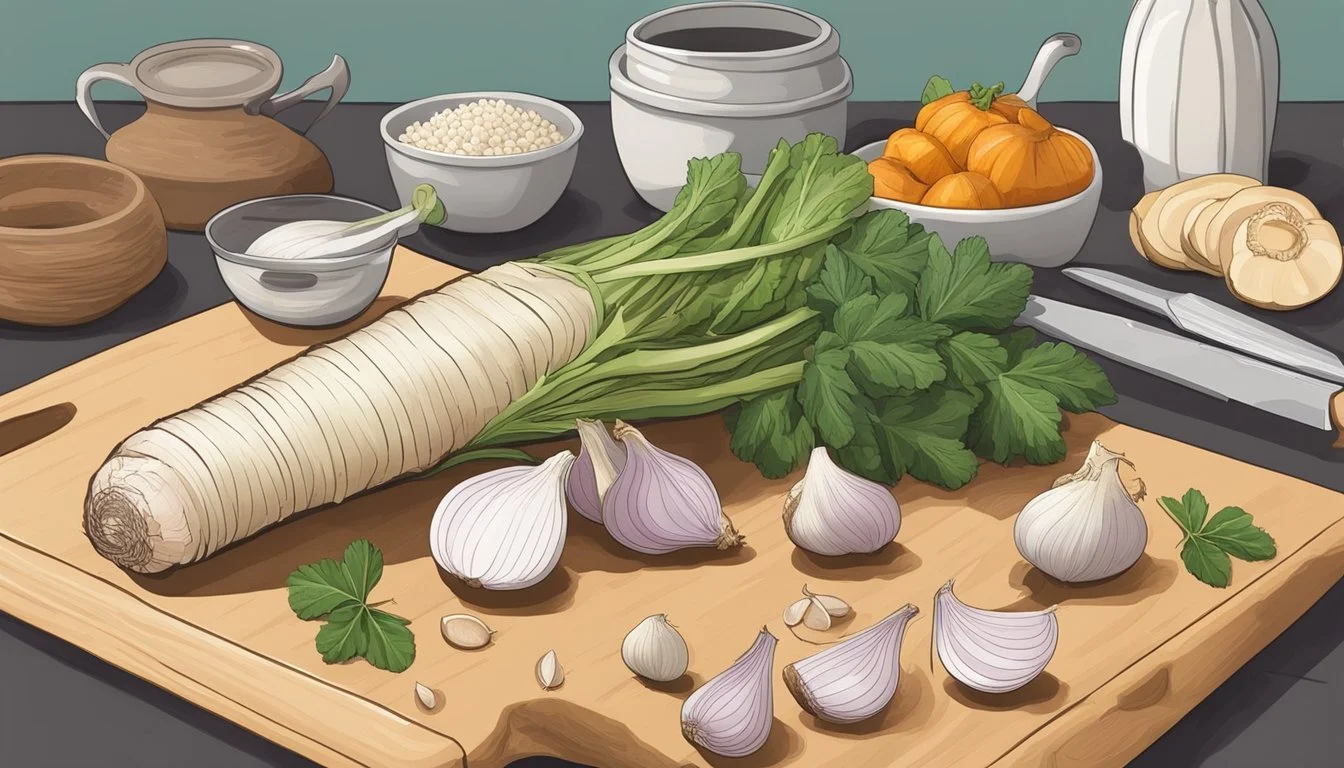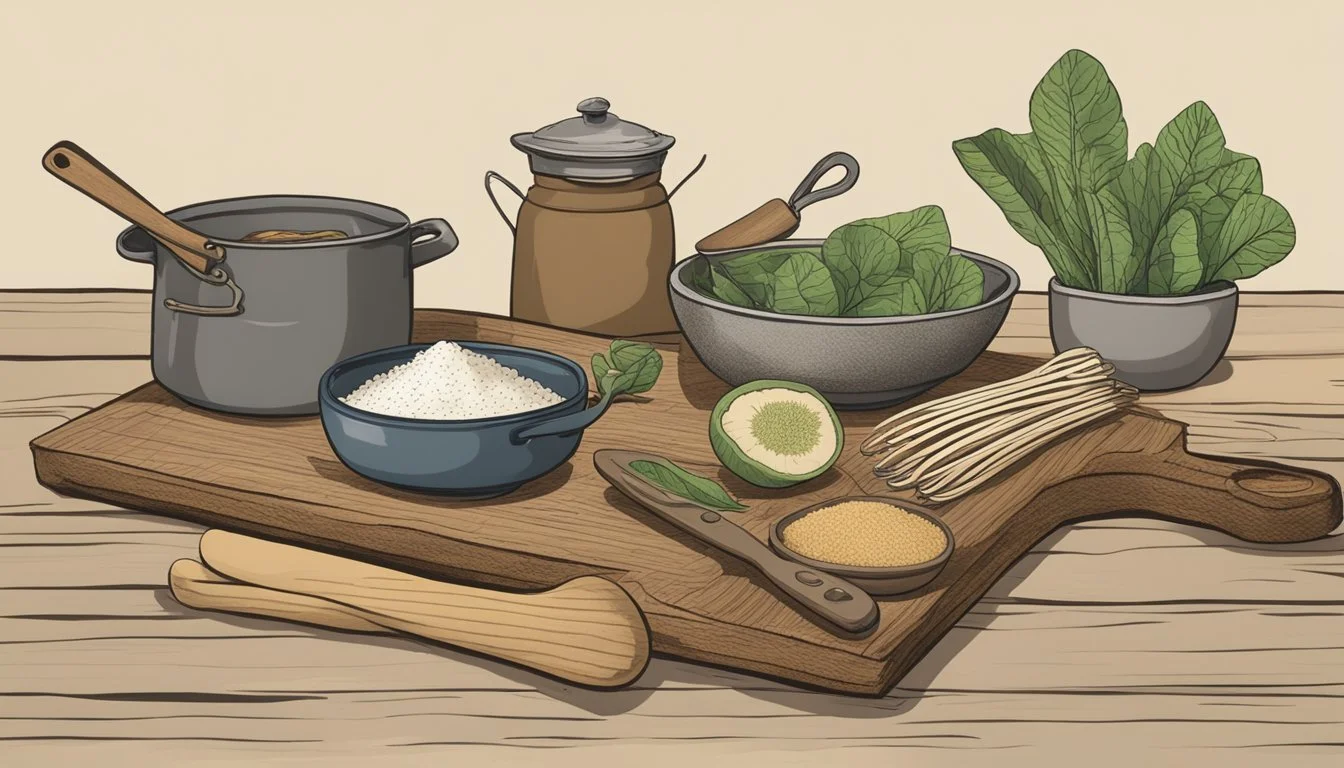How to Cook with Yautia (Taro Root)
A Guide to Starchy Comfort Foods
Yautia, also known as taro root, is a starchy tuber that is a culinary staple in many parts of the world. With its ability to bring comfort and heartiness to meals, it's a versatile ingredient that can be prepared in a myriad of ways. It’s important to properly prepare yautia by peeling off its brown skin and chopping it into pieces before cooking to ensure it is soft and palatable.
Cooking with yautia isn’t just about boiling or mashing; it can be transformed into a range of dishes from savories to sweets. The root can be sautéed, roasted, or even incorporated into stews (What wine goes well with stews?) and soups, providing a nutritious boost and a unique flavor profile. The flesh of yautia varies in color by variety, ranging from white to violet-tinged, each with distinctive characteristics that lend themselves to different recipes.
Its cultural significance is reflected in many traditional recipes from around the globe. In the Dominican Republic, it’s used to make a creamy mash often served alongside meats and salads, while in other cuisines, yautia is glazed with honey, roasted with garlic and herbs, or made into rich, velvety sauces for pasta. The adaptability and comforting nature of yautia make it an excellent ingredient for those looking to explore the world of root vegetables in their cooking repertoire.
Understanding Taro: An Overview
Taro is a globally recognized root vegetable prized for its starchy texture and nutritional benefits. It is a key ingredient in various cuisines offering unique flavors and health advantages.
What Is Taro?
Taro, scientifically known as Colocasia esculenta, is a root vegetable indigenous to Southeast Asia and India. It's recognized for its brown, fibrous skin and white flesh with purple specks. In culinary practices, taro is lauded for its versatility, as it can be boiled, fried, roasted, or mashed, making it a popular starchy component in dishes ranging from entrées to desserts.
Nutritional Profile
Taro's nutritional content underscores its status as a beneficial dietary choice. It is low in calories yet rich in fiber, which can aid in digestive health and help stabilize blood sugar levels. A 100-gram serving of taro contains approximately:
Calories: 142
Fiber: 2.2g
Moreover, taro provides a significant amount of potassium, critical for maintaining heart health. It also offers a suite of important vitamins and minerals, including magnesium, vitamin C, and vitamin B6, among others. These nutritional components make taro a worthy addition to a health-conscious diet.
Culinary Uses of Taro
Taro, known for its versatility in the kitchen, may be prepared in numerous ways to bring its mild, earthy flavor and starchy texture to diverse dishes. This section delves into how taro is utilized globally and through various recipes.
Taro in Global Cuisine
In global cuisine, taro takes various forms. It appears as the base of the Hawaiian dish poi, made by mashing cooked taro until it reaches a smooth, sticky consistency. In Asia, taro is a common ingredient in stews and soups, where it acts both as a thickener and a flavor enhancer.
Asia: Integrated into soups, stews, and even sweet desserts.
Africa: Often used in fufu, a starchy side.
Polynesia: The root of the traditional dish, poi.
Versatile Recipes
When considering recipes, taro's adaptability truly shines. Here are specific ways taro can be integrated into various meals:
Savory Dishes: Dice taro for use in curries or fry to create crispy taro chips.
Taro Desserts: Taro paste is a sweet element in bubble tea and pastries.
Breads and Cakes: Baked into taro cakes or crafted into soft, enriched bread.
Fusion Cooking: Modern chefs employ taro in innovative fusion dishes, combining traditional elements with contemporary flavors.
Whether incorporated into age-old traditional meals or modern gastronomic creations, taro root is a quintessential staple for starchy comfort.
Prepping and Cooking Taro
When handling taro root, the proper preparation is crucial as its skin can be irritant to some people, and it is important to understand the various methods to bring out the starchy vegetable's rich flavors.
Peeling and Preparation
It is recommended to use gloves while peeling taro root to avoid skin irritation. They should wash the taro thoroughly and use a vegetable peeler to remove the skin. Once peeled, the taro should be cut into uniform pieces to ensure even cooking. It is critical to keep the cut taro submerged in water to prevent discoloration.
Necessary tools: Gloves, Vegetable peeler, Knife, Bowl of water
Steps:
Wash the taro root thoroughly.
Put on gloves to protect the hands.
Peel the skin off the taro root.
Chop the taro into even pieces.
Submerge the pieces in water.
Cooking Methods
There are several ways to cook taro root, including boiling, mashing, roasting, and frying.
Boiling: To boil taro, they should place the pieces in a pot, cover them with water, and bring to a boil. A pinch of salt can be added for flavor. Once cooked, taro can be mashed similarly to potatoes, often blended with ingredients like coconut milk for a creamy texture.
Mash ingredients: Coconut milk, Salt
Roasting: Preheat the oven to 400°F (200°C). Toss the taro pieces with olive oil, garlic, and seasonings such as thyme. Spread them on a baking tray and roast until they are tender and golden brown.
Roasting ingredients: Olive oil, Garlic, Thyme
Frying: One can dice the taro root and sauté it in olive oil over medium-high heat. They can add aromatics like onion and scallion towards the end of cooking for added flavor. The taro should be fried until it's golden and crispy on the outside.
Frying ingredients: Olive oil, Onion, Scallion
Each method brings out a unique flavor profile and texture in the taro, from the creamy, soft consistency of mashed taro to the crisp exterior of fried taro.
Yautia and Taro Differences
Understanding the differences between yautia and taro can enhance one's cooking experience by utilizing their distinct flavors and textures to the fullest.
Yautia Explained
Yautia, scientifically known as Xanthosoma sagittifolium, is a starchy root vegetable to the family Araceae. It exists in various forms, such as Xanthosoma atrovirens and Xanthosoma violaceum, each with subtle differences in color and taste. Yautia's appearance is elongated, similar to that of a carrot or parsnip. It offers a waxy texture and tends to keep its shape upon cooking.
Taste and Texture Comparisons
Taro, or Colocasia esculenta, is round like a potato and is known for its slightly sweet, nutty flavor profile. Yautia, in contrast, has a more neutral taste, making it a versatile addition to a variety of dishes. Texturally, taro can become slimy if not prepared properly, whereas yautia maintains a firmer texture when cooked. This distinction makes yautia a preferred choice for recipes requiring root vegetables to hold their shape.
Taro for Dietary Concerns
Taro root (Yautia) offers excellent flexibility for those with specific dietary needs. It stands out as a gluten-free and vegan-friendly option while also contributing to low-carb diets with its dietary fiber content.
Gluten-Free and Vegan Options
Taro root is inherently gluten-free, making it a suitable carbohydrate source for those with celiac disease or gluten sensitivity. Its versatile nature allows for various preparations, providing staples for vegan diets in the form of baked, steamed, or mashed dishes. Utilizing taro offers a comforting starchy component to meals without the inclusion of animal products or gluten containing grains.
Boiled Taro: Can serve as a gluten-free base for salads or as a substitute in recipes requiring potatoes.
Mashed Taro: With the addition of plant-based milk and seasonings, it becomes an excellent vegan side dish.
Low-Carb and Dietary Fiber
Although not extremely low in carbohydrates, taro root provides a more complex carb option due to its high dietary fiber content, which supports better digestion and can assist in maintaining blood sugar levels. The fiber found in taro also promotes satiation, potentially aiding in weight management.
Dietary Fiber per 100g Serving: Approx. 5g, a significant portion of the recommended daily intake.
Carbs per 100g Serving: About 35g, with a complex structure aiding sustained energy release.
Note: The carbohydrate content in taro is higher than some other low-carb alternatives, but its high fiber content and other nutritional benefits make it a valuable addition to a balanced diet.
Storing and Handling Taro
Proper storage and handling of taro root are essential to maintain its freshness and ensure safety during preparation. Taro root should be kept in a cool, dry place before use, and one must be aware of its natural irritants prior to cooking.
Storage Tips
Temperature: To store taro, one should place it in a cool, dry environment, ideally within a refrigerator. Refrigeration can extend the root's freshness for a couple of weeks.
Environment: The refrigerator's crisper drawer is an optimal spot, allowing for a stable temperature and humidity that helps keep taro from drying out or rotting.
Freezing: For long-term storage, one can freeze taro. It should be peeled, cut if desired, and blanched before freezing. Once prepped, taro should be placed in an airtight container or heavy-duty freezer bags.
Freezer Settings: Ensure the freezer is at 0°F (-18°C) or lower for ideal freezing conditions, allowing taro to last for up to six months.
Safety and Toxicity
Toxicity Awareness: Raw taro contains calcium oxalate, making it toxic to ingest before cooking. Proper cooking is required to neutralize these compounds.
Handling Precautions: One should handle taro with care, wearing gloves to peel or cut the root as the skin can cause irritation due to the calcium oxalate.
Cooking: Always thoroughly cook taro to ensure the breakdown of irritants in both the skin and flesh, making it safe to eat and digest.
Taro in Popular Culture
Taro has made its mark in popular culture, particularly through its distinctive presence in beverages, desserts, and comfort foods. Its versatility has made it a staple ingredient in various cultural dishes around the world.
Taro in Beverages and Desserts
Taro Milk Tea: A popular beverage in Asian tea shops, taro milk tea is known for its rich, creamy texture and sweet, nutty flavor. Made with taro paste or powder, it combines the starchy comfort of the root with the refreshing properties of tea.
Desserts: Taro paste, derived from the root, is a common filling in Asian sweets like mooncakes and pastries. It is savored for its dense, smooth consistency and is a favored alternative to red bean paste in many traditional recipes.
Influence on Comfort Foods
Comfort Food: Taro fulfills the role of comfort food in many cultures, where its starchy goodness provides a satisfying foundation for numerous dishes. Its adaptability allows it to be baked, boiled, or fried to complement a variety of meals.
Fritters and Poi: In Caribbean and Hawaiian cuisines, taro takes the form of fritters and poi. Taro fritters are crispy on the outside, tender on the inside, and often served with dipping sauces. Poi, a traditional Hawaiian dish, is made by mashing cooked taro until it reaches a smooth, sticky consistency, offering a unique taste and texture experience.
Taro Around the World
Taro root, known scientifically as Colocasia esculenta, enjoys a prominent place in the culinary traditions of various cultures. It stands as a staple food that is prepared and appreciated in differing forms across the globe.
Cultural Significance
In Asia, taro is deeply intertwined with cultural lore and festivities. For instance, during the Mid-Autumn Festival, some Chinese communities prepare taro as a symbol of good fortune. In Hawaii, kalo (Hawaiian taro) is more than just a food source; it is considered the symbolic “elder brother” of the Hawaiian people, underpinning its vital cultural and spiritual importance.
Latin America and the Caribbean also treat yautia (a term often used interchangeably with taro) with high regard. In Puerto Rico and the Dominican Republic, this root vegetable is essential in traditional dishes. It defines the earthy flavors (What wine goes well with earthy flavors?) and hearty textures that characterize Caribbean cuisine.
Regional Specialties
Unearthing regional specialties reveals the versatility of taro:
In Southeast Asia, taro is frequently used in desserts such as the popular taro balls in Taiwanese bubble tea.
Across the Caribbean, one can savor it in savory sancocho, a meat-and-root vegetable stew brimming with local flavors.
Dominican cooking takes pride in including yautia in various dishes, puréed, boiled, or stewed to enhance the dish's complexity.
Horquetas, a type of Italian pasta noodle, is paired with taro in a creamy, rich pasta dish, illustrating the adaptability of taro beyond traditional boundaries.
Taro's use in these regional cuisines underlines its global culinary reach and its ability to adapt to various taste profiles and cooking methods.
Experimenting with Taro
Taro root, known as yautia, offers a world of culinary potential beyond traditional recipes. With its versatile texture and mild flavor, experimenting with taro in the kitchen can lead to a wealth of innovative dishes and novel taste profiles.
Innovative Cooking Ideas
One can tap into taro's adaptability by incorporating it into a variety of cooking methods. It can be roasted to bring out its sweetness, mashed for a creamy side dish, or sliced and baked into chips for a crispy treat. Here are several creative ideas:
Roasted Taro Cubes: Toss taro with olive oil and roast until golden brown.
Taro Fries: Cut taro into matchsticks, season with herbs, and bake for a healthier alternative to traditional fries.
Mashed Taro: Combine with coconut milk for a rich, creamy texture.
Creating New Flavor Combinations
Chefs can create exciting new flavor combinations that highlight taro's subtle taste. Some ingredients that pair well with taro include:
Coconut milk: for a sweet and creamy fusion
Sesame oil and honey: adding a nutty and sweet glaze to sautéed taro
Garlic and rice vinegar: for a savory punch when glazing or roasting.
By using taro as a canvas, the potential for fusion in both sweet and savory dishes is considerable. Taro can be the base for desserts like puddings or integrate well into savory stews and curries, where its starchy quality contributes to the overall texture.
Enhancing Taro Dishes
The versatility of taro root can be fully realized by careful pairing with complementing flavors and the judicious use of herbs and spices. Here are some specific ways to elevate the humble taro into a gourmet ingredient.
Taro Pairings and Accents
Savory Pairings:
Garlic and Olive Oil: Minced garlic sautéed in olive oil brings out a savory depth in taro when roasted or pan-fried.
Coconut Milk: For a creamy texture with a tropical twist, taro can be cooked in coconut milk, enhancing its natural sweetness and soft texture.
Black Pepper: A simple sprinkling of freshly ground black pepper can add a surprising kick and elevate the flavor profile of taro-based dishes.
Sweet Accents:
Ripe mango cubes can add a sweet and tangy contrast to creamy taro preparations such as purées or desserts.
Herbs and Spices
Herbs:
Thyme: A pinch of thyme can impart an aromatic and earthy note to taro, especially when it forms part of stews or root vegetable medleys.
Spices:
Apart from black pepper, other spices such as cinnamon or nutmeg may be introduced in small amounts to create warmth in sweet taro dishes like pies or puddings.
By integrating these specific pairings and accents, chefs and home cooks alike can transform taro into a dish that offers both comfort and a sophisticated palette of flavors.







